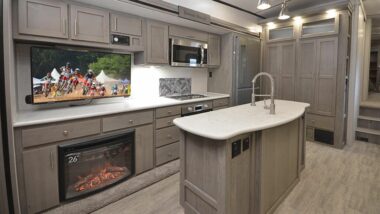Table of Contents Show
If you’ve lived or traveled in an RV in the winter (or for a lengthy amount of time), chances are you’ve dealt with RV condensation. Condensation forms when warm moist air meets cool surfaces, or vice versa. RV condensation is the water droplets that form on your RV walls and windows and make things feel wet.
Condensation in RVs can cause a lot of problems! RV condensation can cause mold and mildew to form in your RV on walls, under the mattress, and more.
Mold and mildew can be more than just a nuisance – they are a health problem. Because of this (and because you want to take great care of your RV) battling RV condensation is a must for any RVer, full or part-time.

What Causes RV Condensation?
Several factors play a role in condensation forming inside of your RV. Condensation can form in your RV in any season, although condensation issues are more common in winter. The key elements in causing RV condensation to form are:
Temperature and Humidity
When warm air hits cool surfaces, condensation will form on windows, walls, and more. This can happen when hot summer air hits the cool interior and windows of your RV, or when the warmth of your RV meets cold windows in the winter.
Cooking and Heating
Depending on how small of a space you have, cooking in a way that produces a lot of steam can cause condensation to form in your RV – and so can certain heaters.
Propane heaters also cause condensation to form – in addition to the warm air/cool window combination. Propane produces 4 cubic feet of water vapor for every cubic foot of propane gas it uses. Simply put: propane heat is a moist heat.
How Do I Stop Condensation In My RV?
It is best to take a multi-faceted approach to battling condensation in your RV. And, depending on how severe or prolonged your condensation issue is, you may want to consider adding multiple of the following options to your RV condensation-fighting arsenal.
Moisture Absorbers
Moisture absorbers, like the little silica gel packets found in medication bottles, work by pulling moisture out of the air into themselves.
DampRid is a popular household product for moisture absorption that you can use in your RV. Place a container of DampRid in every room or closet that you can, and be sure to empty it often.
- ATTRACTS AND TRAPS MOISTURE: DampRid Refillable Moisture Absorbers are convenient 10.5-ounce cups that attract and trap…
- ELIMINATES DAMP, MUSTY ODORS: DampRid eliminates odors by absorbing excess moisture that creates damp, musty smells.
Dehumidifier
A critical step in eliminating RV condensation is by dramatically reducing the amount of humidity in your RV. A great way to do that is with a dehumidifier that you can leave running throughout the day and night as you need it.
- 13-PINT DESICCANT DEHUMIDIFIER – Highly Efficient Desiccant Rotor Removes Moisture, Odors & Mold While Warming Ambient…
- LIGHTWEIGHT BUT POWERFUL – Enjoy Adjustable Humidity Control & Whisper Quiet Operation for Small Spaces Up to 270…
Dual-Pane Windows
Dual-pane RV windows leave a pocket of air between them that acts as an insulating barrier – so when the air inside your RV hits the window, it won’t be enough of a temperature shock to cause condensation to form. Dual pane windows can be expensive, but there are DIY options out there that involve using plexiglass and a bit of elbow grease.
Run the Air Conditioner
An air conditioner can have a dehumidifying effect when the condenser is on. This is a great option to lower the humidity levels in your RV, but it’s not ideal during the winter.
Open a Window
Crack a window for an hour or two a day to allow the moist air in your RV to escape and dry outdoor air in.
Use Your Vent Fan
Crack open and turn on that vent fan – especially when you’re showering or cooking! The steam from showers and cooking can add a ton of humidity to the indoor air, and by turning on your vent fan you don’t give it time to settle in.
Open Cabinet and Closet Doors
Especially if you’re going to be away from your RV or have it in storage for any amount of time. Enclosed spaces will start to grow mold and mildew quicker than other places. Leaving them open will allow for airflow and less of a chance of mildew forming.
Avoid the Southeast
Do we have to explain this one? Nothing against the Southeast – it is a truly beautiful part of the country! But… that humidity!
The Southeast is basically a sauna. A giant, beautiful, outdoor sauna. Full of bugs. The great part about RVing is that you can go anywhere you want! So hit the road and head to drier parts of the US if condensation is becoming too much of an issue.
Avoiding Condensation Issues in an RV
Condensation in your RV can be annoying at the least, and if it goes unchecked, it can cause mold, mildew, and funky smells. You won’t be able to 100% eliminate all condensation in your RV, but you can take steps to reduce the severity and the consequences.
The keys to preventing RV condensation are proper insulation, dehumidifying, and, if at all possible, head to a drier climate!
Last update on 2025-01-19 / Affiliate links / Images from Amazon Product Advertising API









We found alot condensation on most of our windows. We took out each window and replaced the seal around the window and after the windows were put back in, never had another issue with moisture.
We use a dehumidifier in our travel trailer and it works great. No problem with condensation.